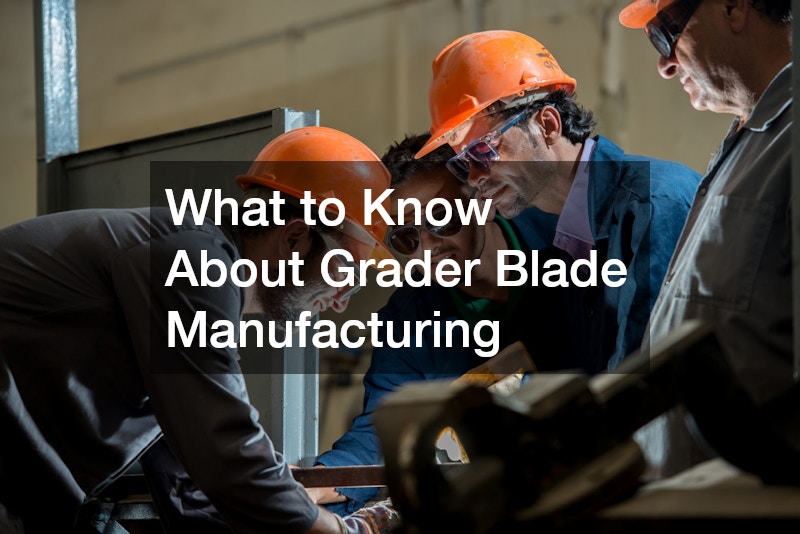Explore the essential aspects of grader blade manufacturing, a critical component in the construction and road maintenance industries. This article sheds light on the top questions and nuances involved in the process, providing a comprehensive understanding of the subject. Grader blades are vital in leveling surfaces, removing debris, and enabling smooth and efficient infrastructure development.
What Materials Are Used in Grader Blade Manufacturing?
1.1 Steel Alloys
Steel alloys are predominantly used in grader blade manufacturing due to their exceptional strength and durability. Among these, high-carbon steels and boron steels are favored for their ability to withstand harsh working conditions. The choice of alloy directly impacts the blade’s performance, influencing its ability to cut through tough materials and its longevity under repetitive use.
Manufacturers carefully select alloys based on their specific properties, such as resistance to wear and tensile strength. The composition of these alloys often includes elements like carbon, manganese, and chromium to enhance desired characteristics. Advanced metallurgical research continues to refine these blends, optimizing the balance between flexibility, strength, and wear resistance.
Another consideration in selecting materials is the cost-effectiveness related to their properties. Customers demand products that offer not only superior performance but also good value for money. The ongoing evolution in alloy technology aims to offer sustainable solutions with minimal environmental impact, addressing both economic and ecological concerns.
1.2 Treatment Processes
Heat treatment is a critical stage in enhancing the performance of steel alloys used in grader blades. This process involves heating and cooling the steel to alter its physical and sometimes chemical properties. Key objectives in heat treatment include increasing hardness, improving grain structures, and relieving internal stresses within the material.
The hardening process, including quenching and tempering, increases the blade’s resistance to wear without compromising its toughness. Quenching involves rapidly cooling the heated steel to lock in the desired crystalline structure. Tempering follows by reheating to a specific temperature to reduce brittleness while maintaining essential strength.
Such treatment processes require precise control and expertise to ensure consistency and reliability in the final product. Technological advancements and automation have streamlined these processes, resulting in blades that consistently meet demanding industry standards. Suppliers invest in state-of-the-art equipment to uphold quality and expand manufacturing capacity, reflecting the importance of technological innovation.
1.3 Environmental Considerations
The environmental impact of manufacturing processes, including blade production, has become a significant focus in recent years. Manufacturers strive to employ sustainable practices in sourcing and processing materials. Recycling steel and implementing waste reduction strategies are common initiatives aimed at decreasing carbon footprints.
The production of steel alloys requires significant energy, prompting the industry to seek cleaner energy sources and more efficient methods. Efforts include reducing emissions through technological improvements and adopting renewable energy where feasible. These practices not only meet legal environmental requirements but also appeal to eco-conscious customers.
Sustainability practices extend beyond production, influencing product lifecycles and end-of-life disposal. Designing blades for durability reduces the frequency of replacement, thereby lowering waste generation. Additionally, testing new eco-friendly materials could reshape the manufacturing landscape in the coming years, highlighting a continuous drive towards environmentally responsible manufacturing.
How Does the Manufacturing Process Work?
2.1 Design and Prototyping
The design phase is the foundation of grader blade manufacturing, where engineers define specifications tailored to performance needs. Computer-aided design (CAD) tools facilitate the creation of precise blueprints that guide the subsequent stages. Prototyping allows for testing and refining these designs, ensuring optimal functionality and efficiency of the final product.
Through iterative testing, manufacturers identify potential improvements in design, which might include adjustments for better material flow or enhanced cutting efficiency. Prototyping also provides a practical means to predict performance under various operating conditions. These design precursors are essential for overcoming potential obstacles before entering mass production.
The feedback from prototyping can lead to innovative adjustments such as improved blade geometry or weight distribution. By addressing design challenges early, manufacturers minimize costly revisions and delays in later production stages. This proactive approach also provides a competitive edge, as it ensures the production of reliable, high-performance grader blades that meet customer expectations.
2.2 Production Techniques
The production of precision grader blades involves a combination of cutting-edge techniques, including cutting, welding, and forming. Each technique plays a crucial role in shaping the raw material into a finished product that meets strict industry standards. Advanced machines ensure precision in dimensions, crucial for maintaining alignment and performance.
Welding joins various components, such as reinforcements and attachment points, adding structural support and functionality to the blade. The welding process must maintain rigorous quality control to prevent defects that could compromise blade durability. The precision in welding directly affects the blade’s ability to withstand high loads and resist impacts.
Automation in manufacturing has increased efficiency and consistency in production processes. Robots handle repetitive tasks, ensuring uniformity in critical operations like cutting and assembly. The integration of automation also enhances worker safety by reducing exposure to hazardous environments and by handling heavy materials.
In conclusion, understanding the materials, processes, and innovations in grader blade manufacturing is crucial for appreciating its role in modern infrastructure development and maintenance. This sector is characterized by advanced steel alloys, meticulous manufacturing techniques, and a commitment to quality and sustainability. With ongoing technological advancements and emerging trends, the industry is equipped to meet future challenges and contribute significantly to global infrastructure ambitions.
.

